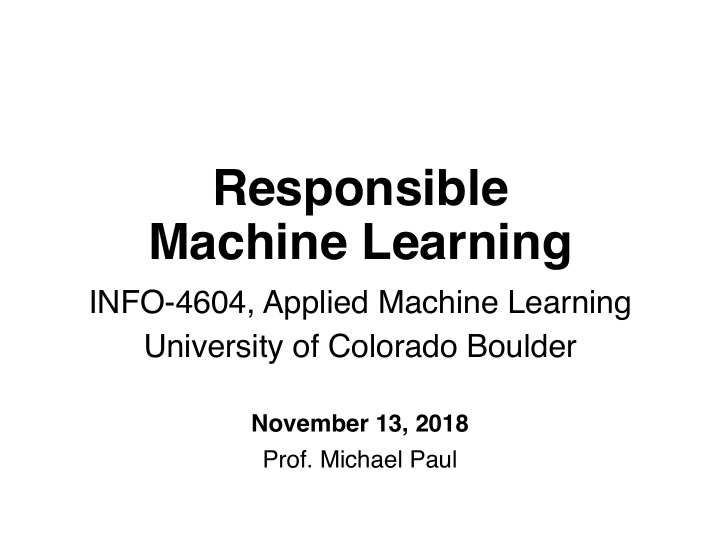



Responsible Machine Learning INFO-4604, Applied Machine Learning University of Colorado Boulder November 13, 2018 Prof. Michael Paul
Is Machine Learning Dangerous?
Is Machine Learning Dangerous? • “Doomsday” scenarios not likely any time soon • Algorithms are not “intelligent” enough • But machine learning can potentially be misused, misleading, and/or invasive • Important to consider implications of what you build
Principles for Accountable Algorithms Statement from Fairness, Accountability, and Transparency in Machine Learning organization https://www.fatml.org/resources/principles-for-accountable-algorithms Algorithms+and+the+data+that+drive+them+are+designed+ and+created+by+people+55 There+is+always+a+human+ ultimately+responsible+for+decisions+made+or+informed+ by+an+algorithm.+"The+algorithm+did+it"+is+not+an+ acceptable+excuse+if+algorithmic+systems+make+ mistakes+or+have+undesired+consequences,+including+ from+machine5learning+processes.
Principles for Accountable Algorithms Responsibility • Make available externally visible avenues of redress for adverse individual or societal effects of an algorithmic decision system, and designate an internal role for the person who is responsible for the timely remedy of such issues. Explainability • Ensure that algorithmic decisions as well as any data driving those decisions can be explained to end-users and other stakeholders in non-technical terms. Accuracy • Identify, log, and articulate sources of error and uncertainty throughout the algorithm and its data sources so that expected and worst case implications can be understood and inform mitigation procedures. Auditability • Enable interested third parties to probe, understand, and review the behavior of the algorithm through disclosure of information that enables monitoring, checking, or criticism, including through provision of detailed documentation, technically suitable APIs, and permissive terms of use. Fairness • Ensure that algorithmic decisions do not create discriminatory or unjust impacts when comparing across different demographics (e.g. race, sex, etc).
Fairness
Fairness How does this type of error happen? Possibilities: • Not enough diversity in training data • Not enough diversity in test data • Not enough error analysis
Fairness Suppose your classifier gets 90% accuracy… Scenario 1: Scenario 2:
Bias Biases and stereotypes that exist in data will be learned by ML algorithms Sometimes, those biases will be amplified by ML
Zooming out… Barbie Martin(Shkreli,( now(in(prison A(woman’s(hand Carly(Fiorina,(former(HP(CEO,( 2016(presidential(candidate • First(woman(after( 206$images!
Zhao et al (2017): • Training data: Women appeared in ‘cooking’ images 33% more often than men • Predictions: Women appeared 68% more often
Privacy Training data is often scraped from the web Personal data may get scooped up by ML systems • Are users aware of this? How do they feel about it?
MegaFace dataset: 4.7 million photos of 627,000 individuals, from Flickr users
Use and Misuse Machine learning can predict: • if you are overweight • if you are transgender • if you have died People may build these classifiers for legitimate purposes, but could easily be misused by others
Case Study Wu and Zhang (2016), “Automated Inference on Criminality using Face Images” Can we predict if someone is prone to committing a crime based on their facial structure? This study claims yes, with 90% accuracy Good summary of why the answer is probably no: http://callingbullshit.org/case_studies/case_study_criminal_machine_learning.html
Case Study How was the dataset created? • Criminal photos: government IDs • Non-criminal photos: professional headshots What did the classifier learn? • “The algorithm finds that criminals have shorter distances between the inner corners of the eyes, smaller angles between the nose and the corners of the mouth, and higher curvature to the upper lip.”
Case Study If your tool seems dystopian: • Consider whether this is really something you should be building… • One argument: someone will eventually build this technology, so better for researchers to do it first to understand it • Still, proceed carefully: understand potential misuse • Be sure that your claims are correct • Solid error analysis is critical • Misuse of an inaccurate system even worse than misuse of an accurate system
Recommend
More recommend